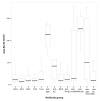Prevalence of antibodies to Ro-52 in a serologically defined population of patients with systemic sclerosis
- PMID: 19267890
- PMCID: PMC2654555
- DOI: 10.1186/1740-2557-6-2
Prevalence of antibodies to Ro-52 in a serologically defined population of patients with systemic sclerosis
Abstract
Background: Antibodies against Ro-52 have been described in patients with a broad spectrum of autoimmune disease, most commonly in association with anti-Ro-60 in systemic lupus erythematosus and Sjogrens syndrome. However, in inflammatory myositis anti-Ro-52 is frequently present without anti-Ro-60 and is closely linked to the presence of aminoacyl-tRNA synthetase (aats) antibodies. To date there have been no comprehensive reports on the frequency of anti-Ro-52 in systemic sclerosis (SSc), a disease characterised by hallmark autoantibodies that occur in non-overlapping subsets. Clinically, each antibody-defined group has a distinct pattern of organ involvement, some featuring myositis.
Objectives: To determine the frequency of anti-Ro-52 in serologically defined groups of SSc patients and to investigate a possible link with myositis-associated autoantibodies.
Methods: Serum samples from 1010 patients with SSc and 55 and 32 patients with anti-aats and anti-Ku respectively were tested for the presence of anti-Ro-52 using a commercial ELISA.
Results: The prevalence of anti-Ro-52 was 15-38% in nine of the eleven sub-groups. There were no significant differences in mean anti-Ro-52 levels in these groups with the exception of that defined by the presence of anti-U1-RNP. In the remaining groups defined by anti-Ro-60 and anti-aats, anti-Ro-52 was present in 92% and 100% respectively. In sera from non-SSc patients with anti-aats, anti-Ro-52 was detected in 64%.
Conclusion: Anti-Ro-52 is present throughout the SSc population. It is neither more prevalent in the myositis-associated antibody groups nor does it segregate with any other major SSc-specific autoantibodies. The co-existence of anti-Ro-52 with both anti-Ro-60 and anti-aats is confirmed.
Figures

Similar articles
-
Clinical and serological associations of autoantibodies to the Ku70/Ku80 heterodimer determined by a novel chemiluminescent immunoassay.Lupus. 2016 Jul;25(8):889-96. doi: 10.1177/0961203316640918. Lupus. 2016. PMID: 27252266
-
A subset of systemic sclerosis but not of systemic lupus erythematosus is defined by isolated anti-Ku autoantibodies.Clin Exp Rheumatol. 2013 Mar-Apr;31(2 Suppl 76):118-21. Epub 2013 Jul 23. Clin Exp Rheumatol. 2013. PMID: 23910615
-
Evaluation of a commercial immunoassay for autoantibodies in Chinese Han systemic sclerosis population.Clin Chim Acta. 2019 Apr;491:121-125. doi: 10.1016/j.cca.2019.01.020. Epub 2019 Jan 24. Clin Chim Acta. 2019. PMID: 30685360
-
Clinical and laboratory aspects of Ro/SSA-52 autoantibodies.Autoimmun Rev. 2011 Jan;10(3):150-4. doi: 10.1016/j.autrev.2010.09.005. Epub 2010 Sep 18. Autoimmun Rev. 2011. PMID: 20854935 Review.
-
Anti-RO/SSA and anti-La/SSB antibodies: Association with mild lupus manifestations in 645 childhood-onset systemic lupus erythematosus.Autoimmun Rev. 2017 Feb;16(2):132-135. doi: 10.1016/j.autrev.2016.12.004. Epub 2016 Dec 14. Autoimmun Rev. 2017. PMID: 27988434 Review.
Cited by
-
Comparative study of immunofluorescent antinuclear antibody test and line immunoassay detecting 15 specific autoantibodies in patients with systemic rheumatic disease.J Clin Lab Anal. 2012 Jul;26(4):307-14. doi: 10.1002/jcla.21522. J Clin Lab Anal. 2012. PMID: 22811366 Free PMC article.
-
Systemic Sclerosis-Specific Antibodies: Novel and Classical Biomarkers.Clin Rev Allergy Immunol. 2023 Jun;64(3):412-430. doi: 10.1007/s12016-022-08946-w. Epub 2022 Jun 18. Clin Rev Allergy Immunol. 2023. PMID: 35716254 Free PMC article.
-
A cross-sectional study of autoantibody profiles in the Waikato systemic sclerosis cohort, New Zealand.Clin Rheumatol. 2015 Nov;34(11):1921-7. doi: 10.1007/s10067-015-2981-3. Epub 2015 May 29. Clin Rheumatol. 2015. PMID: 26022620
-
Clinical significance of antibodies to Ro52/TRIM21 in systemic sclerosis.Arthritis Res Ther. 2012 Mar 6;14(2):R50. doi: 10.1186/ar3763. Arthritis Res Ther. 2012. PMID: 22394602 Free PMC article.
-
Autoantibodies in systemic sclerosis overlap syndrome and their correlation with organ damage and survival.Ann Med. 2024 Dec;56(1):2407526. doi: 10.1080/07853890.2024.2407526. Epub 2024 Sep 30. Ann Med. 2024. PMID: 39348269 Free PMC article.
References
-
- McCauliffe DP, Wang L, Satoh M, Reeves WH, Small D. Recombinant 52 kDa Ro (SSA) ELISA detects autoantibodies in Sjogrens syndrome that go undetected by conventional serologic assays. J Rheumatol. 1997;24:860–866. - PubMed
-
- Peene I, Meheus L, Veys EM, De Keyser F. Diagnostic associations in a large and consecutively identified population positive for anti-SSA and/or anti-SSB: the range of associated diseases differs according to the detailed serotype. Ann Rheum Dis. 2002;61:1090–1094. doi: 10.1136/ard.61.12.1090. - DOI - PMC - PubMed
LinkOut - more resources
Full Text Sources
Research Materials

